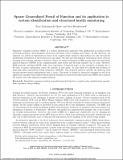Sparse generalized pencil of function and its application to system identification and structural health monitoring
Author(s)
Buyukozturk, Oral; Mohammadi Ghazi Mahalleh, Reza
DownloadSparce generalized pencil.pdf (3.078Mb)
PUBLISHER_POLICY
Publisher Policy
Article is made available in accordance with the publisher's policy and may be subject to US copyright law. Please refer to the publisher's site for terms of use.
Terms of use
Metadata
Show full item recordAbstract
ingularity expansion method (SEM) is a system identification approach with applications in solving inverse scattering problems, electromagnetic interaction problems, remote sensing, and radars. In this approach, the response of a system is represented in terms of its complex poles; therefore, this method not only extracts the fundamental frequencies of the system from the signal, but also provides sufficient information about system's damping if its transient response is analyzed. There are various techniques in SEM among which the generalized pencil-of-function (GPOF) is the computationally most stable and the least sensitive one to noise. However, SEM methods, including GPOF, suffer from imposition of spurious poles on the expansion of signals due to the lack of apriori information about the number of true poles. In this study we address this problem by proposing sparse generalized pencil-of-function (SGPOF). The proposed method excludes the spurious poles through sparsity-based regularization with ℓ1-norm. This study is backed by numerical examples as well as an application example which employs the proposed technique for structural health monitoring (SHM) and compares the results with other signal processing methods.
Date issued
2016-04Department
Massachusetts Institute of Technology. Department of Civil and Environmental EngineeringJournal
Proceedings of SPIE 9805, Health Monitoring of Structural and Biological Systems 2016
Publisher
Society of Photo-Optical Instrumentation Engineers (SPIE)
Citation
Mohammadi-Ghazi, Reza, and Oral Buyukozturk. “Sparse Generalized Pencil of Function and Its Application to System Identification and Structural Health Monitoring.” Proceedings of SPIE 9805, Health Monitoring of Structural and Biological Systems 2016, 20 March, Las Vegas, Nevada, SPIE, 2016. © 2016 SPIE
Version: Final published version
ISBN
9781510600461